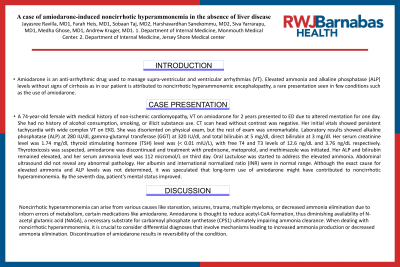Tuesday Poster Session
Category: Liver
P4018 - A Case of Amiodarone-induced Noncirrhotic Hyperammonemia in the Absence of Liver Disease
Tuesday, October 24, 2023
10:30 AM - 4:00 PM PT
Location: Exhibit Hall

Has Audio
- SY
Siva Naga Srinivas Yarrarapu, MD
Monmouth Medical Center/RWJBH
Long Branch, NJ
Presenting Author(s)
Jayasree Ravilla, MD1, Farah Heis, MD1, Sobaan Taj, MD2, Harshavardhan Sanekommu, MD2, Siva Naga Srinivas Yarrarapu, MD1, Medha Ghose, MD3, Andrew Kruger, MD1
1Monmouth Medical Center/RWJBH, Long Branch, NJ; 2Hackensack Meridian Jersey Shore University Medical Center, Neptune, NJ; 3Monmouth Medical Center, Long Branch, NJ
Introduction: Amiodarone is an anti-arrhythmic drug used to manage supra-ventricular and ventricular arrhythmias (VT). Elevated ammonia and alkaline phosphatase (ALP) levels without signs of cirrhosis as in our patient is attributed to noncirrhotic hyperammonemic encephalopathy, a rare presentation seen in few conditions such as the use of amiodarone.
Case Description/Methods: A 74-year-old female with medical history of non-ischemic cardiomyopathy, VT on amiodarone for 2 years presented to ED due to altered mentation for one day. She had no history of alcohol consumption, smoking, or illicit substance use. CT scan head without contrast was negative. Her initial vitals showed persistent tachycardia with wide complex VT on EKG. She was disoriented on physical exam, but the rest of exam was unremarkable. Laboratory results showed alkaline phosphatase (ALP) at 280 IU/dl, gamma-glutamyl transferase (GGT) at 320 IU/dl, and total bilirubin at 5 mg/dl, direct bilirubin at 3 mg/dl. Her serum creatinine level was 1.74 mg/dl, thyroid stimulating hormone (TSH) level was (< 0.01 mIU/L), with free T4 and T3 levels of 12.6 ng/dL and 3.76 ng/dL respectively. Thyrotoxicosis was suspected, amiodarone was discontinued and treatment with prednisone, metoprolol, and methimazole was initiated. Her ALP and bilirubin remained elevated, and her serum ammonia level was 112 micromol/L on third day. Oral Lactulose was started to address the elevated ammonia. Abdominal ultrasound did not reveal any abnormal pathology. Her albumin and international normalized ratio (INR) were in normal range. Although the exact cause for elevated ammonia and ALP levels was not determined, it was speculated that long-term use of amiodarone might have contributed to noncirrhotic hyperammonemia. By the seventh day, patient's mental status improved.
Discussion: Noncirrhotic hyperammonemia can arise from various causes like starvation, seizures, trauma, multiple myeloma, or decreased ammonia elimination due to inborn errors of metabolism, certain medications like amiodarone. Amiodarone is thought to reduce acetyl-CoA formation, thus diminishing availability of N-acetyl glutamic acid (NAGA), a necessary substrate for carbamoyl phosphate synthetase (CPS1) ultimately impairing ammonia clearance. When dealing with noncirrhotic hyperammonemia, it is crucial to consider differential diagnoses that involve mechanisms leading to increased ammonia production or decreased ammonia elimination. Discontinuation of amiodarone results in reversibility of the condition.
Disclosures:
Jayasree Ravilla, MD1, Farah Heis, MD1, Sobaan Taj, MD2, Harshavardhan Sanekommu, MD2, Siva Naga Srinivas Yarrarapu, MD1, Medha Ghose, MD3, Andrew Kruger, MD1. P4018 - A Case of Amiodarone-induced Noncirrhotic Hyperammonemia in the Absence of Liver Disease, ACG 2023 Annual Scientific Meeting Abstracts. Vancouver, BC, Canada: American College of Gastroenterology.
1Monmouth Medical Center/RWJBH, Long Branch, NJ; 2Hackensack Meridian Jersey Shore University Medical Center, Neptune, NJ; 3Monmouth Medical Center, Long Branch, NJ
Introduction: Amiodarone is an anti-arrhythmic drug used to manage supra-ventricular and ventricular arrhythmias (VT). Elevated ammonia and alkaline phosphatase (ALP) levels without signs of cirrhosis as in our patient is attributed to noncirrhotic hyperammonemic encephalopathy, a rare presentation seen in few conditions such as the use of amiodarone.
Case Description/Methods: A 74-year-old female with medical history of non-ischemic cardiomyopathy, VT on amiodarone for 2 years presented to ED due to altered mentation for one day. She had no history of alcohol consumption, smoking, or illicit substance use. CT scan head without contrast was negative. Her initial vitals showed persistent tachycardia with wide complex VT on EKG. She was disoriented on physical exam, but the rest of exam was unremarkable. Laboratory results showed alkaline phosphatase (ALP) at 280 IU/dl, gamma-glutamyl transferase (GGT) at 320 IU/dl, and total bilirubin at 5 mg/dl, direct bilirubin at 3 mg/dl. Her serum creatinine level was 1.74 mg/dl, thyroid stimulating hormone (TSH) level was (< 0.01 mIU/L), with free T4 and T3 levels of 12.6 ng/dL and 3.76 ng/dL respectively. Thyrotoxicosis was suspected, amiodarone was discontinued and treatment with prednisone, metoprolol, and methimazole was initiated. Her ALP and bilirubin remained elevated, and her serum ammonia level was 112 micromol/L on third day. Oral Lactulose was started to address the elevated ammonia. Abdominal ultrasound did not reveal any abnormal pathology. Her albumin and international normalized ratio (INR) were in normal range. Although the exact cause for elevated ammonia and ALP levels was not determined, it was speculated that long-term use of amiodarone might have contributed to noncirrhotic hyperammonemia. By the seventh day, patient's mental status improved.
Discussion: Noncirrhotic hyperammonemia can arise from various causes like starvation, seizures, trauma, multiple myeloma, or decreased ammonia elimination due to inborn errors of metabolism, certain medications like amiodarone. Amiodarone is thought to reduce acetyl-CoA formation, thus diminishing availability of N-acetyl glutamic acid (NAGA), a necessary substrate for carbamoyl phosphate synthetase (CPS1) ultimately impairing ammonia clearance. When dealing with noncirrhotic hyperammonemia, it is crucial to consider differential diagnoses that involve mechanisms leading to increased ammonia production or decreased ammonia elimination. Discontinuation of amiodarone results in reversibility of the condition.
Disclosures:
Jayasree Ravilla indicated no relevant financial relationships.
Farah Heis indicated no relevant financial relationships.
Sobaan Taj indicated no relevant financial relationships.
Harshavardhan Sanekommu indicated no relevant financial relationships.
Siva Naga Srinivas Yarrarapu indicated no relevant financial relationships.
Medha Ghose indicated no relevant financial relationships.
Andrew Kruger indicated no relevant financial relationships.
Jayasree Ravilla, MD1, Farah Heis, MD1, Sobaan Taj, MD2, Harshavardhan Sanekommu, MD2, Siva Naga Srinivas Yarrarapu, MD1, Medha Ghose, MD3, Andrew Kruger, MD1. P4018 - A Case of Amiodarone-induced Noncirrhotic Hyperammonemia in the Absence of Liver Disease, ACG 2023 Annual Scientific Meeting Abstracts. Vancouver, BC, Canada: American College of Gastroenterology.
